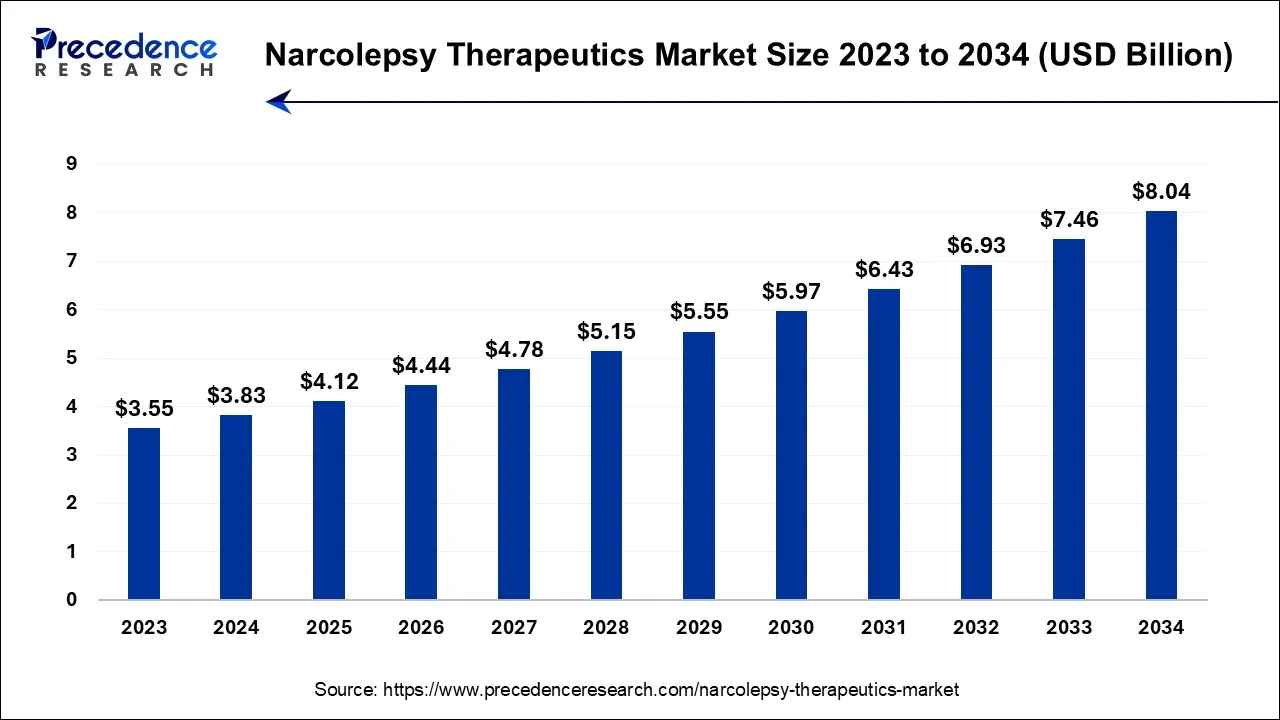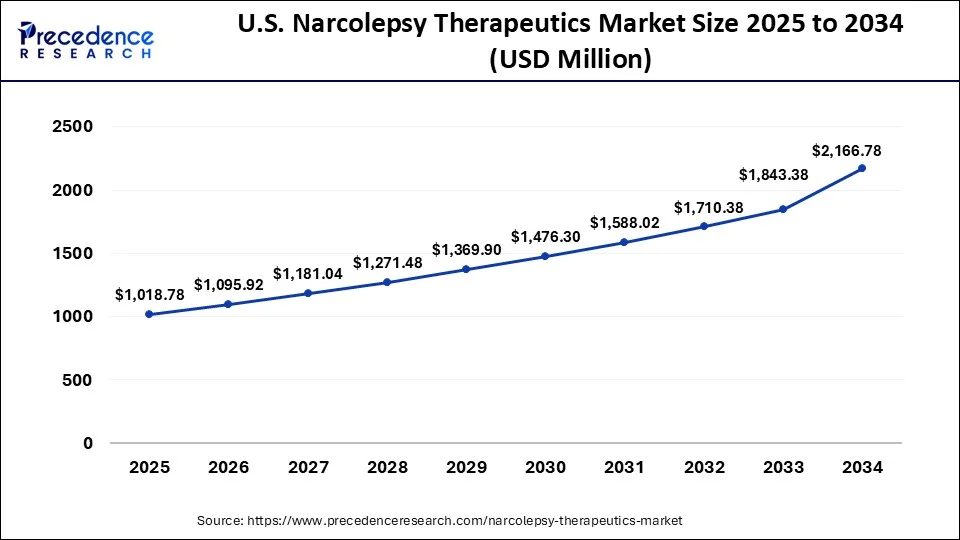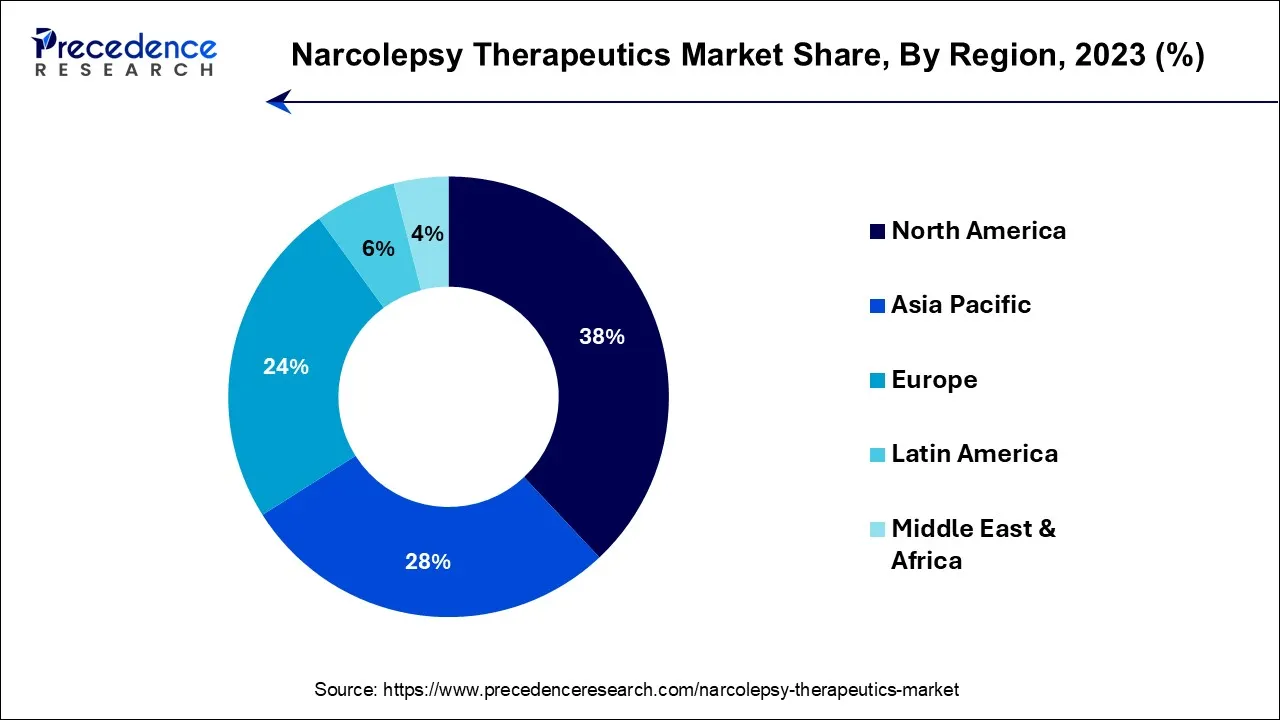September 2024
The global narcolepsy therapeutics market size is calculated at USD 3.83 billion in 2024, grew to USD 4.12 billion in 2025, and is predicted to hit around USD 8.04 billion by 2034, poised to grow at a CAGR of 7.7% between 2024 and 2034. The North America narcolepsy therapeutics market size accounted for USD 1.46 billion in 2024 and is anticipated to grow at the fastest CAGR of 7.82% during the forecast year.
The global narcolepsy therapeutics market size is expected to be valued at USD 3.83 billion in 2024 and is anticipated to reach around USD 8.04 billion by 2034, expanding at a CAGR of 7.7% over the forecast period from 2024 to 2034.

The U.S. narcolepsy therapeutics market size is accounted for USD 1,018.78 million in 2024 and is projected to be worth around USD 2,166.78 million by 2034, poised to grow at a CAGR of 7.84% from 2024 to 2034.

North America has held the largest revenue share 38% in 2023. North America's dominance in the narcolepsy therapeutics market is underpinned by several pivotal factors. Firstly, the region experiences a heightened prevalence of narcolepsy cases, resulting in a substantial patient pool actively seeking therapeutic solutions. Secondly, North America possesses a well-developed healthcare infrastructure, ensuring extensive accessibility to narcolepsy treatments.
Furthermore, the region's robust commitment to research and development, coupled with a favorable regulatory climate, has stimulated the creation and approval of innovative narcolepsy therapies. Lastly, the escalating awareness of sleep disorders, including narcolepsy, across healthcare circles and the general populace has spurred early diagnoses and heightened demand for effective treatments, further cementing North America's preeminence in the market.

Asia-Pacific is estimated to observe the fastest expansion with the highest CAGR of 10.3% during the forecast period. This remarkable growth is attributable to several distinct factors, including robust economic development, heightened public awareness, a burgeoning disposable income, substantial investments in the pharmaceutical and biotechnology sectors, and proactive government initiatives throughout the region. Additionally, the thriving generics industry and enhanced healthcare infrastructure are expected to contribute significantly to the market's expansion in the foreseeable future.
The narcolepsy therapeutics sector embodies the niche realm within the pharmaceutical landscape, exclusively devoted to pioneering and disseminating remedies tailored to address narcolepsy—a protracted neurological affliction characterized by profound diurnal lethargy and abrupt, involuntary bouts of slumber. This market sphere encompasses a spectrum of medicinal formulations encompassing stimulants, alertness-boosting agents, and psychotropic medications, each intricately designed to ameliorate the intricate tapestry of narcoleptic manifestations. Its continual expansion is underpinned by the growing cognizance surrounding narcolepsy and its precision diagnosis.
The cadence of progress in technology and sustained inquiries into the recesses of neuroscientific domains have fostered the emergence of increasingly efficacious therapeutic modalities. Furthermore, this marketplace may foresee further amplification as avant-garde curative paradigms and modalities continue to surface, promising to elevate the quality of life for those ensnared by narcoleptic challenges.
The narcolepsy therapeutics arena constitutes a distinctive enclave within the pharmaceutical domain, specializing in the innovation and dissemination of remedies tailored to combat narcolepsy, a persistent neurological ailment distinguished by profound daytime torpor and unforeseen episodes of slumber. Within this domain, a spectrum of pharmaceutical interventions, including stimulants, vigilance-amplifying agents, and psychoactive medications, is meticulously crafted to mollify the intricate panorama of narcolepsy's clinical manifestations.
The market has steadily expanded over time, propelled by heightened awareness of narcolepsy and advancements in diagnostic precision. Furthermore, the intersection of cutting-edge neuroscience and technological strides has paved the path for increasingly efficacious therapeutic strategies, promising a fertile terrain for narcolepsy treatment.
An instrumental impetus propelling the narcolepsy therapeutics market is the escalating acknowledgment of narcolepsy as a distinct malady within the medical spectrum. As comprehension grows among both healthcare practitioners and the general populace, a larger pool of accurately diagnosed individuals emerges, thereby widening the scope of potential patients. Concurrently, continuous exploration in the domain of neuroscience is unearthing novel insights into the fundamental mechanics of narcolepsy, yielding more precisely targeted and efficacious treatments.
Simultaneously, a noteworthy trend is the innovation of pioneering pharmaceuticals and therapeutic regimens. Pharmaceutical enterprises are dedicating substantial resources to devise fresh medications that not only mitigate daytime drowsiness but also address associated complications such as cataplexy and disrupted sleep patterns. These pioneering strides in drug development augur well for market growth, endowing a more comprehensive spectrum of therapeutic choices.
Notwithstanding the favorable trends, the narcolepsy therapeutics sector confronts its share of impediments. Foremost among these is the underdiagnosis of narcolepsy, with a considerable portion of affected individuals either remaining undiagnosed or receiving inaccurate diagnoses. Ameliorating this scenario necessitates heightening awareness and refining diagnostic precision.
Moreover, navigating the labyrinthine regulatory landscape and enduring the protracted drug approval procedure can substantially delay the introduction of new narcolepsy treatments into the market. The arduous development process for pioneering therapies demands extensive research and rigorous clinical trials, consuming time and financial resources.
Despite the challenges, the narcolepsy therapeutics arena harbors numerous prospects for enterprises. Companies that channel investments into research and development to fabricate avant-garde, more efficacious treatments stand poised to gain a competitive edge. Additionally, venturing into underserved regions with limited access to narcolepsy medications presents growth vistas.
Furthermore, forging strategic alliances and partnerships between pharmaceutical corporations and research institutions can expedite the development and endorsement of novel narcolepsy therapies. These synergistic collaborations can harness the collective expertise of both entities to fast-track innovative treatments to the market.
In summation, the narcolepsy therapeutics market holds potential aplenty, fueled by heightened awareness, ongoing exploration, and the advent of groundbreaking treatments. Nevertheless, surmounting the challenges of underdiagnosis and regulatory complexities is imperative to fully unlock the market's potential. Simultaneously, capitalizing on business opportunities through innovation and collaborative ventures can propel further growth within this highly specialized sphere.
| Report Coverage | Details |
| Growth Rate from 2024 to 2034 | CAGR of 7.7% |
| Market Size in 2024 | USD 3.83 Billion |
| Market Size by 2034 | USD 8.04 Billion |
| Largest Market | North America |
| Base Year | 2023 |
| Forecast Period | 2024 to 2034 |
| Segments Covered | By Treatment and By Product |
| Regions Covered | North America, Europe, Asia-Pacific, Latin America, and Middle East & Africa |
Increasing awareness and diagnosis
Increasing awareness and diagnosis of narcolepsy are pivotal drivers propelling the growth of the narcolepsy therapeutics market. As understanding of narcolepsy deepens among healthcare professionals and the general public, more individuals are being correctly identified and diagnosed with this chronic neurological condition. This surge in awareness fosters a larger pool of individuals seeking treatment and therapeutic interventions, thereby expanding the market's potential patient base.
Accurate diagnosis is crucial in providing timely and effective narcolepsy management, which, in turn, drives demand for therapeutics. Healthcare practitioners are better equipped to identify and address narcoleptic symptoms, leading to more patients actively seeking medical help. Additionally, the upswing in awareness catalyzes research and development endeavors, incentivizing pharmaceutical corporations to channel investments into pioneering medications and therapeutic strategies.
These innovations, in turn, furnish an expanded array of treatment alternatives, capable of enhancing patient well-being and life quality. In sum, the convergence of amplified awareness and enhanced diagnostic precision forms a pivotal bedrock underpinning the sustained expansion of the narcolepsy therapeutics market, benefiting both patients and the pharmaceutical industry.
Underdiagnosis and misdiagnosis
The narcolepsy therapeutics market grapples with a notable constraint arising from underdiagnosis and misdiagnosis. This intricate neurological disorder, narcolepsy, often presents symptoms that overlap with other sleep disorders or mental health conditions, resulting in its insufficient detection or incorrect identification. This diagnostic complexity leads to delays or missed opportunities for individuals to access appropriate treatment, thereby constraining the market's potential patient base.
The ramifications of underdiagnosis and misdiagnosis are dual-fold. Firstly, those individuals who remain undiagnosed or wrongly diagnosed do not pursue or receive the necessary narcolepsy therapies, thus impeding market growth. Secondly, delayed diagnosis can lead to the manifestation of more severe symptoms and complications, diminishing the efficacy of treatment upon initiation. Mitigating this constraint necessitates a concerted endeavor to augment healthcare professionals' awareness of narcolepsy and enhance diagnostic precision.
Furthermore, public awareness initiatives can empower individuals to recognize narcolepsy's symptoms and seek timely medical evaluation. Surmounting these diagnostic obstacles is imperative to expand the narcolepsy therapeutics market and ensure that those affected obtain the requisite care.
Telemedicine and digital health
Telemedicine and digital health solutions are catalyzing opportunities in the narcolepsy therapeutics market by revolutionizing how healthcare is accessed and managed. These technologies enable remote consultations, monitoring, and engagement for narcolepsy patients, providing a convenient and accessible means to receive care and support. For individuals with narcolepsy, telemedicine platforms and mobile applications offer real-time access to sleep specialists and healthcare providers, ensuring timely interventions and treatment adjustments.
Moreover, digital health tools can facilitate comprehensive sleep tracking, allowing patients to monitor their sleep patterns and symptom fluctuations. This data can enhance the precision of diagnosis and treatment planning, leading to more effective therapies. Furthermore, telemedicine breaks down geographical barriers, making expert narcolepsy care available to underserved areas and populations, ultimately expanding the market's reach and providing new growth opportunities for pharmaceutical companies and healthcare providers in the field of narcolepsy therapeutics.
According to the treatment, the narcolepsy with cataplexy segment has held a 37% revenue share in 2023. The dominance of the narcolepsy with cataplexy segment within the narcolepsy therapeutics market can be attributed to its unique characteristics. This form of narcolepsy, distinguished by sudden muscle weakness triggered by emotional stimuli, presents a more severe clinical profile. Consequently, patients afflicted with cataplexy often necessitate specialized and intensified therapeutic interventions, such as sodium oxybate-based medications.
This segment garners substantial attention from pharmaceutical firms, leading to a broader array of potent treatment solutions. Moreover, the profound impact of cataplexy symptoms on patients' lives fuels a heightened demand for effective therapies, solidifying its substantial market share within the narcolepsy therapeutics domain.
The narcolepsy without cataplexy segment is anticipated to expand at a significant CAGR of 9.7% during the projected period. The substantial growth within this segment can be credited to two fundamental factors: the prevalent occurrence of the ailment and the amplification of public awareness via awareness campaigns facilitated by various networks, such as the U.S. narcolepsy network and Europe narcolepsy network. approximately 80% of cases fall within the ambit of type 2 narcolepsy. An anticipated uptick in disease diagnoses is poised to correspond with a pronounced escalation in the treatment rate for this condition.
In 2023, the sodium oxybate segment had the highest market share of 47% on the basis of the product. The sodium oxybate segment holds a major share in the narcolepsy therapeutics market due to its effectiveness in managing narcolepsy symptoms, including excessive daytime sleepiness and cataplexy. Sodium oxybate, marketed as Xyrem, is the only FDA-approved medication specifically indicated for narcolepsy treatment.
Its unique mechanism of action and ability to consolidate nighttime sleep contribute to its popularity among healthcare providers and patients. Additionally, its proven track record and established market presence have solidified its dominance in the narcolepsy therapeutics market, making it the preferred choice for many individuals diagnosed with narcolepsy.
The central nervous system stimulants segment is anticipated to expand at the fastest rate over the projected period. The commanding growth of the Central Nervous System (CNS) Stimulants segment within the narcolepsy therapeutics market is primarily attributable to its paramount role in mitigating a foundational symptom of narcolepsy: the pervasive daytime drowsiness. CNS stimulants such as modafinil and methylphenidate serve as the principal therapeutic modality for efficaciously managing this incapacitating manifestation.
By augmenting wakefulness and cognitive alertness, these pharmacological agents empower narcoleptic individuals to lead more productive and functional lives. Their widespread utilization and firmly established effectiveness have firmly entrenched them as linchpins in narcolepsy treatment, thereby solidifying their substantial presence and dominance growth within this specialized domain devoted to addressing the intricate contours of this neurological condition.
Segments Covered in the Report
By Treatment
By Product
By Geography
For inquiries regarding discounts, bulk purchases, or customization requests, please contact us at sales@precedenceresearch.com
No cookie-cutter, only authentic analysis – take the 1st step to become a Precedence Research client
September 2024
August 2024
October 2024
March 2025